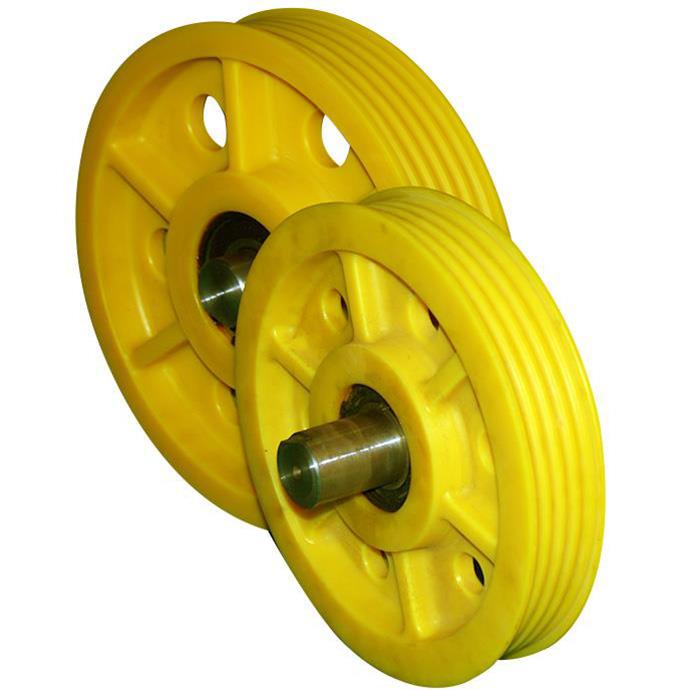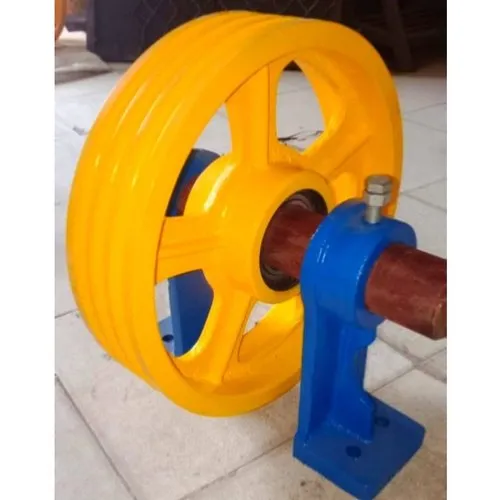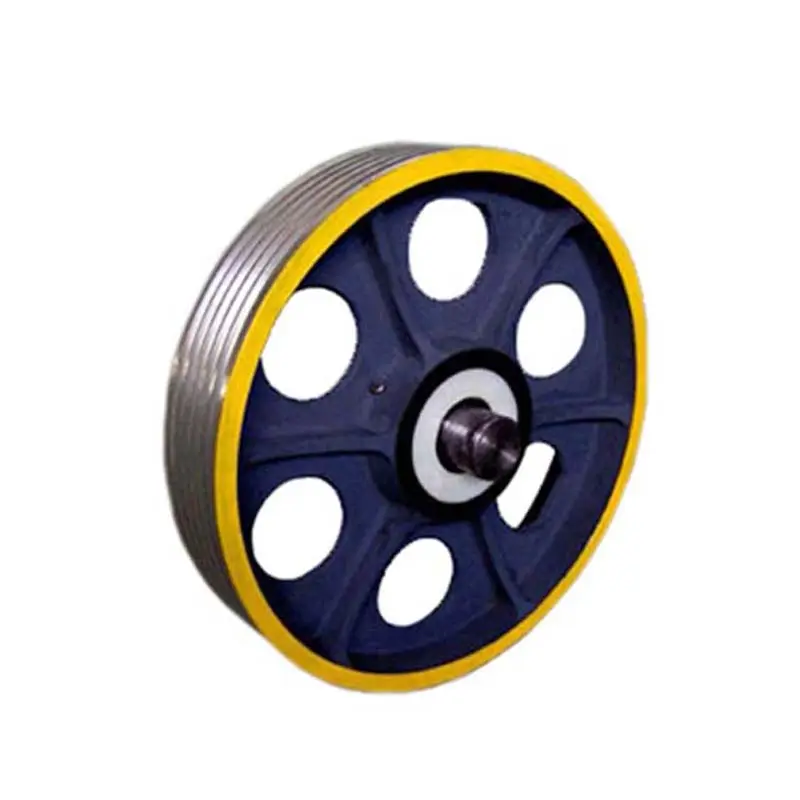Product Description
OEM Engineering Machinery Equipment Accessory-Pulley
Description
|
Name |
Pulley |
|
OEM |
Acceptable |
|
Materials |
EN-GJL-250&EN-GJS-450-10, etc |
|
Weight |
20Kg-100Kg |
|
Manufacturing Process |
Lost foam casting, CNC machining, CMM inspection, Surface treatment |
|
Casting tolerance |
ISO8062 ISO2768 |
|
Inspection items and methods |
Chemical composition: Spectral analysis |
|
Application |
OEM Engineering Machinery Equipment |
|
Package |
Plywood case |
|
Payment terms |
T/T, L/C |
OEM/ODM Request Is Very Welcome!
Production Process
The scale production of vehicle weight is realized by automatic production line, then through machining and accurate inspection, eventually the products come up to good surface quality, highly dimensional accuracy, accurate weight and the best comprehensive cost performance.
Before product development, we will evaluate and highlight the technical requirements, including: material, surface treatment, hardness, weight, important technical requests and customer’s special requests. Meanwhile, we will establish files for each customer, including: technical documents, communication records and the time of technique requests changes, this will help us to provide guarantee for product inspection.
Inspection
We have complete testing instruments and quality control means, thus we can control the quality of products from raw materials to finished products timely and effectively. Our commonly used inspection equipment are: Spectral analyzer, Hardness tester, Micro scope, Roughness tester, CMM, Projector and other gages and tools.
Molds
Mold is the key to producing castings, we have our own mold workshop and mold design engineer, we can ensure the mold development and the rigor of production, manufacturability and the rapidity of mold development, thus we can provide the best guarantee of product development.
Package
According to different products, we’ll choose the most suitable package way for our customers.
Company
About Us
SYI provides OEM Casting & Forging services based on your drawings , samples , or just an idea ! After technical analysis and individual QCP for each project , the most suitable manufacture process will be recommended.
SYI starts our business since 1990 ‘ s of machined and un-machined in a variety of industry . We have over 100,000 products till now with the support of a specialized team including 50 engineers , inspectors and customer services .
Cooperative Brand
| Material: | En-Gjl-250&En-Gjs-450-10 |
|---|---|
| Name: | OEM Pulley |
| OEM: | Acceptable |
| Materials: | En-Gjl-250&En-Gjs-450-10 |
| Transport Package: | Standard Export Package or as Per Your Requirement |
| Specification: | Customized |
| Customization: |
Available
| Customized Request |
|---|
How do you select the right lifting pulley configuration for a specific lifting task?
Selecting the right lifting pulley configuration is crucial for ensuring safe and efficient lifting operations. The appropriate pulley configuration depends on various factors related to the lifting task at hand. Here are the key considerations when selecting the right lifting pulley configuration:
1. Load Capacity: Determine the maximum weight or load capacity that needs to be lifted. This information is crucial in selecting lifting pulleys that can handle the expected load without exceeding their safe working load limits.
2. Lifting Method: Consider the lifting method that will be used, such as vertical lifting, horizontal pulling, or a combination of both. Different pulley configurations, such as single sheave, double sheave, or multiple sheave blocks, are suitable for different lifting methods.
3. Pulley Efficiency: Evaluate the efficiency of the pulley system. Look for pulleys with low friction and smooth-running bearings to minimize energy losses and maximize the mechanical advantage provided by the pulley configuration.
4. Space Limitations: Assess the available space for the lifting operation. Depending on the space constraints, you may need to consider compact pulley configurations or alternative lifting methods that require less spatial clearance.
5. Environmental Factors: Consider the environmental conditions in which the lifting task will take place. Factors such as temperature, humidity, and exposure to corrosive substances may influence the choice of pulley materials and coatings to ensure durability and safe operation.
6. Required Precision: Determine the level of precision required for the lifting task. In some applications, such as delicate installations or precise positioning, a pulley configuration that allows for fine adjustments and controlled movement may be necessary.
7. Accessibility: Consider the accessibility of the lifting area. If the lifting task is in a confined or difficult-to-reach space, you may need to choose a pulley configuration that allows for easy installation, adjustment, and removal.
8. Regulatory Compliance: Ensure that the selected lifting pulley configuration complies with relevant safety standards, regulations, and industry guidelines. Adhering to these standards is essential for maintaining a safe working environment and preventing accidents.
9. Expert Advice: When in doubt, consult with lifting equipment specialists or engineers who have expertise in selecting the right pulley configuration for specific lifting tasks. They can provide valuable insights and recommendations based on their experience and knowledge.
By considering these factors and seeking expert advice when needed, you can select the appropriate lifting pulley configuration for a specific lifting task. The right pulley configuration will ensure safe and efficient lifting operations, minimize risks, and optimize performance.
How are lifting pulleys customized for specific lifting requirements and load capacities?
Lifting pulleys can be customized to meet specific lifting requirements and accommodate different load capacities. Manufacturers offer various customization options to ensure that the pulleys are tailored to the specific needs of the lifting application. Here are some common ways in which lifting pulleys are customized:
1. Load Capacity: Lifting pulleys are designed and manufactured to handle different load capacities. Manufacturers specify the maximum load capacity of each pulley, allowing users to select the appropriate pulley based on their specific lifting requirements. Pulleys can be customized to support light loads, heavy loads, or even extreme loads encountered in specialized lifting applications.
2. Sheave Size and Configuration: The sheave, or the wheel of the pulley, can be customized in terms of size and configuration. Larger sheave diameters provide a greater mechanical advantage, allowing for easier lifting of heavy loads. Manufacturers offer pulleys with different sheave sizes and configurations, such as single sheave, double sheave, or multiple sheaves in a block, to accommodate various lifting needs.
3. Material Selection: The choice of material for the pulley can be customized based on factors such as load capacity, environmental conditions, and industry requirements. Different materials, such as steel, cast iron, aluminum, brass, nylon, plastic, or composite materials, offer varying properties in terms of strength, durability, weight, corrosion resistance, and more. Manufacturers select the appropriate material or combination of materials to ensure that the pulley meets the desired specifications.
4. Bearing Type: Lifting pulleys can be customized with different bearing types to optimize performance and efficiency. Common bearing options include plain bearings, ball bearings, or roller bearings. The choice of bearing type depends on factors such as load capacity, speed, noise requirements, and maintenance considerations. Customizing the bearing type allows for smoother rotation of the pulley, reducing friction and improving overall lifting performance.
5. Mounting Options: Lifting pulleys can be customized with various mounting options to suit different installation requirements. Manufacturers offer pulleys with different mounting configurations, such as fixed mount, swivel mount, or combination mounts, allowing users to select the most suitable option for their specific lifting setup.
6. Special Features: Depending on the specific lifting requirements, lifting pulleys can be customized with special features or accessories. For example, pulleys used in high-temperature environments may have heat-resistant coatings or materials. Pulleys used in corrosive environments may have protective coatings or be made from corrosion-resistant materials. Manufacturers can also incorporate features such as locking mechanisms, integrated lubrication systems, or specialized designs to address unique lifting challenges.
By offering customization options in load capacity, sheave size and configuration, material selection, bearing type, mounting options, and special features, manufacturers ensure that lifting pulleys can be adapted to specific lifting requirements and load capacities. This customization allows users to optimize the performance, efficiency, and safety of their lifting operations.
In which industries and tasks are lifting pulleys commonly used for material handling?
Lifting pulleys are commonly used for material handling in various industries and tasks. Here are some examples:
1. Construction: In the construction industry, lifting pulleys are used for hoisting and moving heavy construction materials, such as steel beams, concrete blocks, and scaffolding components. They are employed in cranes, hoists, and other lifting equipment to facilitate the vertical and horizontal movement of materials at construction sites.
2. Manufacturing: Lifting pulleys play a crucial role in manufacturing facilities for material handling tasks. They are used in assembly lines, warehouses, and distribution centers to lift and transport raw materials, components, and finished products. Lifting pulleys are often integrated into conveyor systems, overhead cranes, and lifting devices to streamline the movement of materials throughout the manufacturing process.
3. Shipping and Logistics: In the shipping and logistics industry, lifting pulleys are utilized for loading and unloading cargo from ships, trucks, and airplanes. They are employed in cranes, gantries, forklifts, and other material handling equipment to efficiently move containers, pallets, and packages within ports, warehouses, and transportation hubs.
4. Mining and Quarrying: Lifting pulleys are essential in mining and quarrying operations for extracting and transporting minerals, ores, and aggregates. They are used in conveyor systems and mining equipment to lift and transfer heavy loads, such as rocks, coal, and bulk materials. Lifting pulleys in mining applications are designed to withstand harsh environments and heavy-duty usage.
5. Agriculture: Lifting pulleys find application in the agricultural industry for material handling tasks. They are used in farming operations to lift and move bales of hay, bags of feed, and agricultural equipment. Lifting pulleys are often integrated into tractor-mounted loaders, barn hoists, and other agricultural machinery to assist in the handling of various farm materials.
6. Warehousing and Distribution: In warehousing and distribution centers, lifting pulleys are extensively used for material handling tasks. They are employed in forklifts, pallet jacks, and automated storage and retrieval systems to lift and transport goods within the facility. Lifting pulleys enable efficient loading and unloading of palletized and packaged products, optimizing the flow of materials in the supply chain.
Lifting pulleys are versatile tools that are widely employed in industries where material handling is a critical aspect of operations. From construction and manufacturing to shipping and logistics, mining and quarrying, agriculture, and warehousing, lifting pulleys enhance efficiency and safety in the movement of materials across various sectors.
editor by CX
2023-11-20




